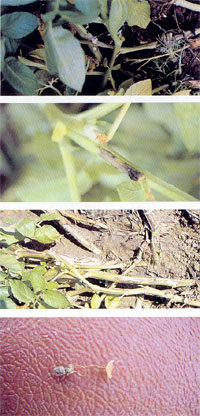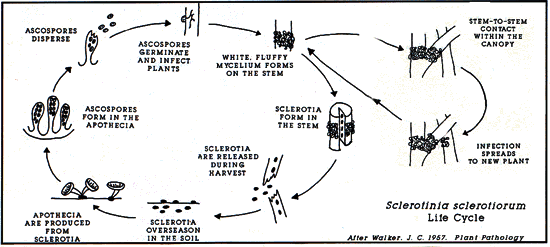Bulletin #2248, Potato Facts: White Mold (Sclerotinia sclerotiorum (Lib.) de Bary)

Bulletin #2248, Potato Facts: White Mold (Sclerotinia sclerotiorum (Lib.) de Bary) (PDF)
By Steven B. Johnson, Ph.D., Extension Crops Specialist
For information about UMaine Extension programs and resources, visit extension.umaine.edu.
Find more of our publications and books at extension.umaine.edu/publications/.
History
Potato producers have noticed white mold disease in Maine since the early 1980s. The disease can reduce yield by as much as 50 percent by causing the death of the above-ground portion of the plant.
White mold is frequently found on beans, peas, carrots, and lettuce, in addition to potatoes. A current host index lists 148 kinds of plants attacked by the white mold pathogen.
Life Cycle
White mold of potatoes is caused by the fungus Sclerotinia sclerotiorum (Lib.) de Bary. (See life cycle chart). This fungus has a very wide host range. The fungus produces white and fluffy mycelium and also produces hard, black, irregularly shaped sclerotia. The sclerotia are varied in size and range from very small to over ½ inch in diameter. The sclerotia are the resting stage. The pathogen overseasons in this form.
Apothecia emerge from sclerotia and are about ¼ inch in diameter. Apothecia are formed at the soil surface and range from funnel-shaped to flat. Their colors include pale orange, pink, light tan, and white. From the apothecia, wind-dispersed ascospores are released and initiate primary infections.
Symptoms
The first symptoms of white mold are wilting of individual stems. Observation of the field wilt can be difficult in the early stages. The white, cottony mycelium of the fungus may be observed on water-soaked lesions on the stems. The lesions are most commonly found at or near the soil line but may appear on lateral branches where soil contact has been made.
As the disease progresses, the mycelium may not be apparent on the stems and lesions on the stem often will turn a bleached white. Wilted stems may have a rotted portion where the stem comes into contact with the soil. Often, there is soft rot associated with the diseased stems.
Sclerotinia sclerotiorum survives in the soil as dormant sclerotia. These sclerotia are capable of remaining viable for many years. The sclerotia germinate apothecia in upper soil layers under conditions of high soil moisture at temperatures above 60 degrees F. With soil movement through cultivation, deeply buried sclerotia can be induced to germinate. Free moisture and high relative humidity are required for ascospore germination and tissue colonization. For this reason, the symptoms are rarely seen before row closure when the relative humidity in the crop canopy increases. Sclerotinia sclerotiorum infections predominate where stems touch the soil.
Once the infection is established, the pathogen produces characteristic white, cottony mycelium. The mycelium is capable of spreading within the canopy and inciting more disease. Sclerotia are formed as a survival mechanism, so these are not often found until the food source is exhausted in the local area of infection or on the plant as a whole. The process of harvesting the potatoes shatters the potato stems, releasing the sclerotia from inside the infected stems. Sclerotia left on the soil surface appear to survive as well as those buried in the soil.
Control
White mold has not been well controlled with crop rotation. Usually, four or more years of a nonhost must be grown to reduce inoculum levels. Currently, the most effective method of controlling white mold on potatoes is a timely application of fungicides. Fungicides should be applied before the fungus attacks the plant and before visible symptoms of the disease. Present information suggests that the best time to apply fungicides is from just before final hilling until row closure, with a subsequent application 10 to 14 days later if rain and relative humidity remain high.
Varieties appear to differ in resistance to the pathogen. “Superior” is the most susceptible variety identified to date. Please consult with your local UMaine Extension County Office for more information on white mold control.
Information in this publication is provided purely for educational purposes. No responsibility is assumed for any problems associated with the use of products or services mentioned. No endorsement of products or companies is intended, nor is criticism of unnamed products or companies implied.
© 1991
Call 800.287.0274 (in Maine), or 207.581.3188, for information on publications and program offerings from University of Maine Cooperative Extension, or visit extension.umaine.edu.
In complying with the letter and spirit of applicable laws and pursuing its own goals of diversity, the University of Maine System does not discriminate on the grounds of race, color, religion, sex, sexual orientation, transgender status, gender, gender identity or expression, ethnicity, national origin, citizenship status, familial status, ancestry, age, disability physical or mental, genetic information, or veterans or military status in employment, education, and all other programs and activities. The University provides reasonable accommodations to qualified individuals with disabilities upon request. The following person has been designated to handle inquiries regarding non-discrimination policies: Director of Equal Opportunity, 5713 Chadbourne Hall, Room 412, University of Maine, Orono, ME 04469-5713, 207.581.1226, TTY 711 (Maine Relay System).


